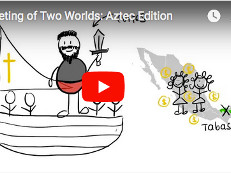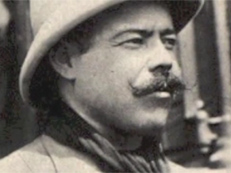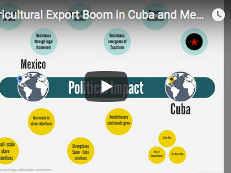Hi all. For this week’s post, I will be reflecting upon this week’s video lecture, entitled “Citizenship and Rights in the New Republics. More precisely, I will be discussing race and its importance in discourse. Stated in the lecture is that “race is a social construct, rather than a biological fact”. This is not true, […]
Posted in Blogs | Tagged with Biology and Genetics, Mexico, politics, race
Hi all. For this week’s post, I will be reflecting upon this week’s video lecture, entitled “Citizenship and Rights in the New Republics. More precisely, I will be discussing race and its importance in discourse. Stated in the lecture is that “race is a social construct, rather than a biological fact”. This is not true, […]
Posted in Blogs | Tagged with Biology and Genetics, Mexico, politics, race
This week I was particularly interested in the Story of Santa Anna. As I am learning about him in the context of Mexican history, I have noticed how he is presented greatly differs from each source. In the context of Mexican history, Santa Anna is sort of a joke. His eleven sporadic presidencies, often weak and corrupt, portray Mexico as incredibly unstable. He was a president that was only present to achieve military victories; when it came to ruling he was absent, even giving leadership to his vice president while he still held the title of presidency. It seems that he is both so contrary to caudillo culture as he is representative. The idea of a caudillo is that he is a “strongman” who uses force yet exerts the most meticulous and paternal care to the people under his protection. Santa Anna as a leader was far from this, often being removed from office or having little control over Mexico. Yet during battles, he emulates the caudillo, fighting with utmost loyalty to protect his people. It seems that the caudillo is a character of the moment rather than a longterm political figure. This is reaffirmed by the high turnover rate; power imbalances led people to living in a constant state of instability.
The story of the slaughterhouse is a critique of the rampant paternalism within the caudillo system. Yet the language seems paternalistic in itself; Echeverría consistently talks of the mob as uneducated people while using derogatory terms. It seems almost impossible that this would have been an effective tool at garnering support for budding liberalism. I also found it interesting to learn in my other class about how Mexico actually banned slavery early in an attempt to stifle American migration to texas as tensions rose surrounding the border. It seems that the liberalism in this sense was not actually about the rights of citizens but in this case, it was more about political power and action.
I did have quite a few questions about the caudillo system that felt slightly unanswered. I was really wondering how this political system managed to expand over such a large area. It seemed surprising to me that Argentina would be just as invested in the caudillo system as Mexico. I was also wondering how the caudillo cycle was actually broken as it seems like it would be challenging to shift to one singular power system. I wondered if pieces like the slaughterhouse affected the challenges to caudillo power.
Posted in Blogs, Week 5 | Tagged with caudillos, Mexico
This week I was particularly interested in the Story of Santa Anna. As I am learning about him in the context of Mexican history, I have noticed how he is presented greatly differs from each source. In the context of Mexican history, Santa Anna is sort of a joke. His eleven sporadic presidencies, often weak and corrupt, portray Mexico as incredibly unstable. He was a president that was only present to achieve military victories; when it came to ruling he was absent, even giving leadership to his vice president while he still held the title of presidency. It seems that he is both so contrary to caudillo culture as he is representative. The idea of a caudillo is that he is a “strongman” who uses force yet exerts the most meticulous and paternal care to the people under his protection. Santa Anna as a leader was far from this, often being removed from office or having little control over Mexico. Yet during battles, he emulates the caudillo, fighting with utmost loyalty to protect his people. It seems that the caudillo is a character of the moment rather than a longterm political figure. This is reaffirmed by the high turnover rate; power imbalances led people to living in a constant state of instability.
The story of the slaughterhouse is a critique of the rampant paternalism within the caudillo system. Yet the language seems paternalistic in itself; Echeverría consistently talks of the mob as uneducated people while using derogatory terms. It seems almost impossible that this would have been an effective tool at garnering support for budding liberalism. I also found it interesting to learn in my other class about how Mexico actually banned slavery early in an attempt to stifle American migration to texas as tensions rose surrounding the border. It seems that the liberalism in this sense was not actually about the rights of citizens but in this case, it was more about political power and action.
I did have quite a few questions about the caudillo system that felt slightly unanswered. I was really wondering how this political system managed to expand over such a large area. It seemed surprising to me that Argentina would be just as invested in the caudillo system as Mexico. I was also wondering how the caudillo cycle was actually broken as it seems like it would be challenging to shift to one singular power system. I wondered if pieces like the slaughterhouse affected the challenges to caudillo power.
Posted in Blogs, Week 5 | Tagged with caudillos, Mexico
Casta Paintings To me, one of the patterns that repeat itself the most in the Casta Paintings is the one where the rest of the characters in the painting are turned towards the light-skinned, Spanish person who’s more often than not a man. It makes sense for the painting to be organized in this wayContinue reading “Week 3”
Posted in Blogs, Week 3 | Tagged with Hypodescent, Mexico, race, Whitening Ideology





